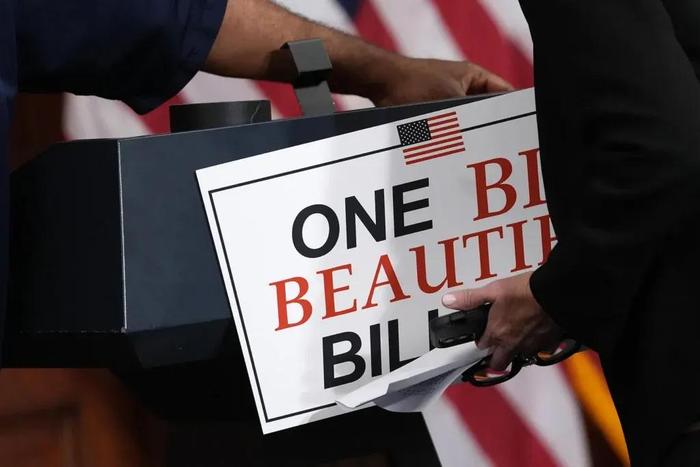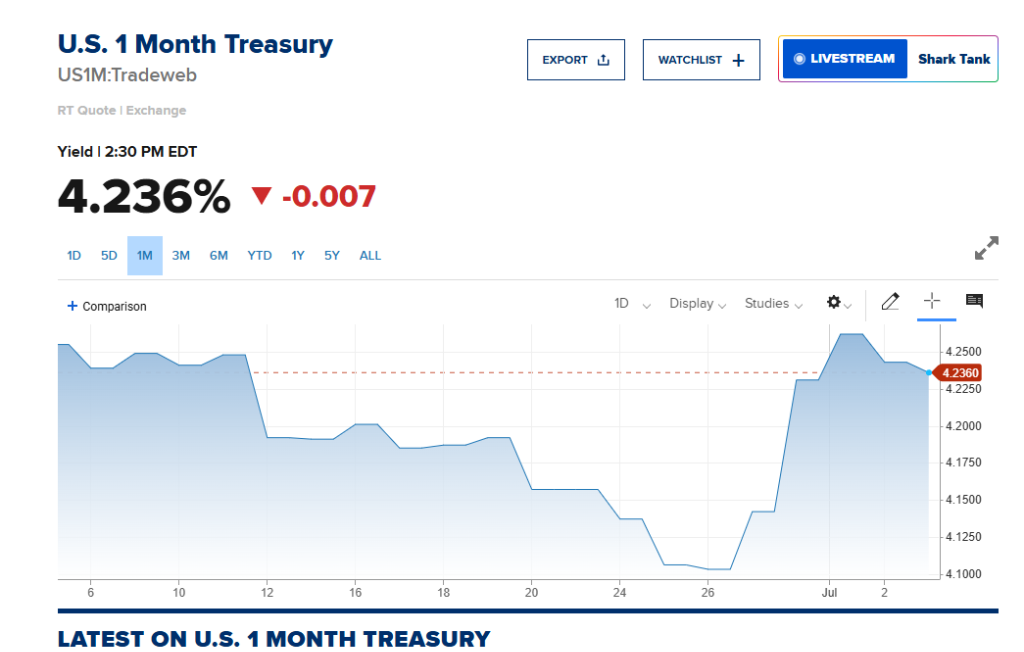
On Friday, July 4, Eastern time, U.S. President Donald Trump signed the large-scale tax cuts and spending bill he pushed - the so-called "big and beautiful" bill, making the bill effective.
With the Trump administration's massive tax cuts and spending bill officially implemented, in order to make up for the future trillions of dollars of fiscal deficits, the U.S. Treasury may start a "supply flood" of short-term Treasury bonds.
The market has already begun to react to future supply pressures. Concerns about the oversupply of short-term government bonds are directly reflected in prices: the yield on 1-month short-term government bonds has risen significantly since Monday. This marks a complete shift in market focus from the sell-off concerns about 30-year bonds earlier this year to the front-end interest rate curve.

For investors, this means that the wind direction of the bond market is quietly changing, especially the trend of short-term interest rates, which is worth paying attention to.
The core of the bill: tax cuts, expenditure cuts, and debt raising
Think of it as a "fiscal magic": giving red envelopes to corporations and individuals (tax cuts) while tightening the pockets of some public projects (cutting spending), and finally raising the state's borrowing ceiling (raising the debt ceiling) in one fell swoop.
Let's dismantle the core content of this bill and explain this "fiscal balance technique" in the most popular language.
1. Tax reduction: red envelopes will continue to be issued, and key groups will be increased
This bill can be said to be a victory for the tax cut party! It permanently extends Trump's 2017 tax cuts, which were due to end by the end of 2025.
不仅如此,还新增了一些新福利,比如:对小费收入、加班工资等特定收入进行减税;给老年人、有孩子的家庭和企业送上更多税收优惠。
To put it simply: the money is less paid, and the wallet is more bulging. It's not a free lunch, though. The CBO (Congressional Budget Office) estimates that this series of tax cuts will cost the federal government about $4.5 trillion in tax revenue over the next decade.
2. Expenditure cuts: The province's important provinces, medical insurance, and environmental protection are all affected
Since the tax cut has cost so much money, you have to find a place to save it, right? Hence the massive cuts in public spending.
The CBO expects the bill to save about $1.1 trillion over the next decade, the most controversial of which:
Medicaid has been "slashed": eligibility has been tightened; increasing the job requirements for low-income groups; The result is that nearly 12 million Americans are expected to lose health insurance coverage.
Green energy subsidies are also "cooling": including tax credits for buying electric vehicles ($7,500 for new cars and $4,000 for used cars) will end from September 30 this year; Dozens of other green energy incentives have also been eliminated. In order to save money, some social welfare and environmental protection projects have had to be sacrificed.
3. Debt raising: solve the urgent need first, but the long-term pressure is greater
Finally, in order to deal with the huge deficit gap caused by the tax cuts, the bill also includes a key action: raising the debt ceiling of the US federal government by $5 trillion at once!
This means that there will be no "technical default" in the US in the short term, and the market is temporarily relieved. But the CBO also reminds us of one fact:
After the implementation of the entire bill, the US national debt will increase by another $3.4 trillion over the next decade, and the total US debt will reach a staggering $39.6 trillion by 2034. It's like if you pay with your credit card, and although the bill doesn't blow up for the time being, the pressure will be even greater next month.
The essence of this bill is to find a "dangerous balance" between cutting taxes to stimulate the economy, cutting spending to control costs, and borrowing to stay afloat. The crisis has eased in the short term, but in the long term, fiscal risks are quietly accumulating.
Borrowing short-term debt to make up for the deficit: cost-effective, but not simple
First, according to the nonpartisan Congressional Budget Office (CBO), this new bill would add up to $3.4 trillion to the U.S. national deficit between fiscal years 2025 and 2034. This is not a small amount, so the government has to find a way to raise money.
In the face of such a large financing demand, the issuance of short-term treasury bonds seems to be an option that is both economical and in line with the preferences of policymakers. Why?
1. Cost-effective
Look at the current interest rate: Although the yield on short-term Treasury bonds with a maturity of one year or less has risen to more than 4%, it is still much cheaper than the issuance rate of 10-year Treasury bonds that is close to 4.35%.
For the government, it is a little bit to save a little bit when interest expenses have become a burden, so the lower financing costs in the short term are indeed quite attractive.
2. Conform to government preferences
President Trump himself has publicly expressed his preference for short-term notes rather than long-term bonds. Finance Minister Bessant also said that it "does not make sense" to increase the issuance of long-term bonds in the current situation.
However, this strategy is not entirely risk-free!
Rising inflation triggers rate hikes: If inflation suddenly increases, the Fed may have to raise interest rates. Then as Treasury yields rise, so does the cost of short-term financing.
Recession leads to lower demand: A recession or contraction in economic activity can reduce savings, which in turn reduces the demand for short-term notes. This means that the government may need to pay higher interest rates to attract buyers.
In response to large fiscal deficits, the U.S. government has chosen to issue short-term Treasury bonds because it reduces costs and is in line with the preferences of the current leadership. However, this approach is not without risk, and future fluctuations in funding costs and economic uncertainty can pose challenges.
The supply floodgates are about to be opened, can the market catch it?
供给端:巨量供应来袭
首先来看看供给端的情况:美国财政部借款顾问委员会(TBAC)建议的短期国债占未偿还债务总额的比例上限是20%左右。但美银的利率策略师团队预测,为了消化新增的财政赤字,这个比例可能会很快攀升到25%。
市场需要准备好迎接比官方建议水平更多的短期票据供应。换句话说,政府打算大量发债,而投资者得有心理准备——短期内市场上会有很多新的短期国债。
需求端:市场信心满满?
再看看需求端的情况:就在几个月前,投资者还在为30年期长期国债的抛售潮和其收益率飙升至5%以上的风险担忧不已。但现在,大家的关注点完全变了方向。现在的焦点转移到了短期国债上:这么多新发的短期国债会不会导致市场供过于求,引发动荡呢?
不过,市场似乎对此并不太担心。为什么呢?因为有以下几个原因:
货币市场基金的“胃口”很大:景顺固定收益(Invesco Fixed Income)的北美投资级信贷主管Matt Brill指出,目前市场上有高达7万亿美元的货币市场基金,它们对前端债务(即短期国债)有着“持续不断的需求”。
Attractive real yields: Mark Mark, president and chief investment officer of Pennsylvania Mutual Asset Management According to Heppenstall, the current real rate of return looks quite attractive, and many people want to put their money to work. "I don't think the next crisis is going to come from short-term Treasuries," he said. There's still a lot of cash surging in the market. ”
The Fed's backing: If something does go wrong, the Fed will also find a way to support any supply-demand imbalance. In other words, the Fed is like a "safety net" that gives everyone more confidence.
While the supply of short-term Treasuries is set to increase substantially, the market seems confident that it will be able to take on this additional supply, largely due to the strong demand from money market funds and the attractiveness of real yields. Coupled with the support of the Federal Reserve, a major crisis is unlikely in the short term.
For investors, this means that while there may be some volatility in the near term, short-term Treasuries remain a relatively sound option overall.





